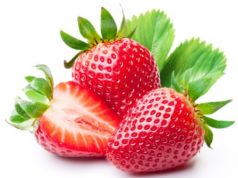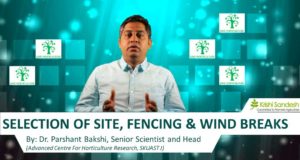In this Article we will discuss Guava Cultivation. How ever, if you want to know how Guava is a medicine for modern diseases, you can also plan to get the book from here
Guava (Psidium guajava), the apple of tropics, is one of the most common fruits in India. It is the fourth most important fruit in area and production after mango, banana and citrus. Being hardy, it gives an assured crop even with little care, and is good for rainfed areas also.
Ideal Climate and Soil for Guava Cultivation
Successful Guava cultivation is grown under tropical and sub-tropical climate. In areas with distinct winter season, the yield tends to increase and quality improves.
It can be grown up to an altitude of 1515 m above mean sea level. Older plants can tolerate drought. High temperature at the time of fruit development can cause fruit drop.
Guava trees are very hardy and can thrive on all types of soils, but are sensitive to water logging. The best soils for guava cultivation are deep, loamy and well drained.
Guava Cultivars
Allahabad Safeda
The fruits are large in size, round in shape, smooth skinned and yellowish white. The flesh is white, firm, soft having pleasant flavor, high soluble solids and vitamin C content. It can withstand drought conditions.
Note: You can buy Allahabad safeda guava seeds from here
Lucknow – 49 (also known as Sardar Guava)
Its fruits are large, roundish, ovate in shape, skin primrose, yellow and white pulp, very sweet and tasty. The total soluble solids and vitamin C are high. Plant is vigorous.
Guava Planting
The guava planting should be done in pits of 1m x 1m x 1m size filled with mixture of FYM and soil during rainy season (July-August) or in spring (February-March) at a distance of 6 m x 6 m.
Propagation and Rootstock of Guava
Guava plants grown directly from seed give poor fruit yield and quality, and come into bearing late. Seeds should be used for rootstock raising. Subsequently, inarching or budding (patch or shield) can be done for propagation.
In recent times, stooling has been found cheapest and easiest method of propagation. As seeds loose viability after extraction, they should be sown immediately.
Soaking of seeds in water for 12 hours gives about 90 per cent germination. Time of guava propagation is Feb-March and July-August. Guava can also be successfully propagated by air layering.
Training and Pruning
The plant should be trained to a low-headed system of open centre or delayed open centre keeping scaffold limbs having wide crotch angles. Pruning is not generally required every year, however, terminal shoots may be headed back to stop overcrowding of trees.
Also Read: How to Grow Lychee
Guava Cultivation: Manuring and Fertilization
Although guava is grown without application of any manure and fertilizer, it responds well in their application by giving higher yield and better quality fruit.
| FYM | Fertilizer requirement (g / tree) | |||
| Age of tree (Year) | (Kg/tree) | Urea | Diammonium Phosphate | Muriate of potash |
| 1 | 5 | 55 | 35 | 15 |
| 2 | 10 | 115 | 70 | 35 |
| 3 | 15 | 170 | 105 | 50 |
| 4 | 20 | 225 | 140 | 65 |
| 5 | 25 | 345 | 170 | 85 |
| 6 | 30 | 415 | 205 | 100 |
| 7 | 35 | 565 | 240 | 115 |
| 8 & onwards | 40 | 700 | 275 | 135 |
Note:- The fertilizer should be applied in two split doses i.e. 1st week of May for rainy season crop and 1st week of July for winter season crop.
Irrigation Guidance for Guava Cultivation
Guava is mostly grown under rainfed conditions and irrigation is generally not practiced but wherever the irrigation is available, it should be given in summer and October/Novermber as it enhances the yield of guava tree by increasing fruit set.
Intercropping of Guava
Guava orchards may be intercropped with short growing leguminous crops like mash, moong, guar and vegetables during pre-bearing period.
Aftercare of Guava
Pre-harvest spray of calcium nitrate (2%) two weeks before harvest improve quality at the time of harvest of guava, whereas, the spray of 150 ppm silver nitrate at 5 weeks before harvest and another spray at three weeks after first spray increases the shelf life of guava satisfactorily upto 6 days at room temperature.
GA, 90 ppm, sprayed 30 days before harvest improves the fruit quality at harvest and also increases the shelf life of guava.
Guava Harvesting and Yield
In guava cultivation, grafted plants come into bearing at the age of 3 years and peak harvesting periods are August-September for rainy season crop and Jan-Feb. for winter season crop.
Guava develops best flavour and aroma only when they ripe on tree. A ten year old guava tree gives a yield, up to 100 kg of fruit.
Crop regulation
The guava fruits produced in the rainy season are not of high quality and have poor shelf life. Spray 10 per cent urea or 600 ppm NAA during April-May when maximum flowers have opened.
This eliminates rainy season crop so that winter guava crop is heavy and of superior quality. One leaf pair pruning of guava plants in the first week of may offers an effective method for avoiding rainy season crop, resulting into more yield and better quality in winter season crop.
Key Diseases Found in Guava Cultivation and their Management
| Symptoms | Management |
| Fruit Rot (Phyotophthora nicotianae)
The disease starts at the styler end. Whitish cottony mass develops very fast as the fruit starts ripening and covers the entire fruit surface in few days. Humid weather favours the disease. The diseased fruit drops from the tree. |
Spray the tree with combination of fungicides metalaxyl + mancozeb (250 g/100 L water) or metalaxyl (100 g/100 L water) or fosetyl-al (300g/100 L water) as soon as the disease is observed, repeat sprays at 15 days interval. |
| Anthracnose/Die Back (Colletotrichum psidii)
Symptoms appear on the leaves, twigs, flowers and fruits. Necrotic grey lesions are formed on the leaves, twigs start drying from downwards. Floral infection may lead to mummification or symptoms appear on ripe fruits as circular, slightly sunken lesions with raised margins. Spots coalesce to form corky and hard lesions developing cracks in them. Symptoms on mature fruits appear as pinkish spots with sticky spore mass in the centre. |
i) Prune dead twigs, remove mummified fruits hanging on the trees and burn.
ii) Spray copper oxychloride (300g/100L water), mancozeb (250 g/100 L water) or captan (300 g/100L water) soon after pruning, repeat spray at 15 days interval after fruit set. iii) Bury deep in soil the diseased/rotten unmarketable fruits fallen on the ground. |
| Wilt (Fusarium oxysporum f.sp.psidii)
Browning and wilting of leaves, stem discolouration accompanied by death of the branches on one side. The whole plant, sometimes shows wilting symptoms and finally dies. The causal pathogen may sometimes appear on the stem. |
i) Prune/uproot the wilted plants and burn.
ii) Treat the soil with formaldehyde (1 formaldehyde; 7 water) or gypsum (2 kg/tree) to prevent further spread. iii) Severe pruning of diseased branches followed by soil drenching with carbendazim (100 g/100 L water) or metalaxyl + mancozeb (250g/100L water) or fosetyl-al (300g/100 L water) at an interval of three months. |
| Twig Blight and Canker (Cytospora chrysosperma)
The diseased plants show sick look, less foliage and blighted appearance. Canker appears on bud scars, wounds, twigs or in crotches. Embossed, globose and cankerous pimples appear on diseased twigs. Bark becomes loose with amber yellow exudates becoming horny on drying. The symptoms are quite pronounced under wet conditions. Stromatic fungal masses appear on the surface of diseased twigs. |
i) Scratch the dead bark alongwith some healthy portion. Burn the pruned dead twigs and disinfect the wound with Bordeaux paste or copper oxychloride paste.
ii) Spray the treated trees with copper oxychloride (300g/100L water) or carbendazim (100g/100L water or thiophanate methyl 100ml/100L water). Repeat sprays in March and June. iii) Remove severely infested trees and burn. |
| Collar Rot (Phytophothora sp., Sclerotium sp, Diplodia sp.)
Bark of the plant at collar region turns brown, cracks and some times peels off. |
Scrap the infected portion along with some healthy area and apply Bordeaux paste or copper oxychloride paste. Drench soil with metalaxyl + mancozeb (250g/100L water) or fostyl-al (100g/100L water). |
| Withe tip (Colletotrichum gloeosporioides)
The disease causes shedding of leaves and withering of tips of branches. On leaves, light green spots appear which later turn brown. Spots usually develop on the tips or margins of leaves. Black dots develop on leaves and twigs with pinkish ooze of spore mass. |
Prune off the diseased twigs and treat cut ends with Bordeaux paste. Give 1-2 follow up sprays with copper oxychloride (300g/100L water) or carbendazim (100g/100L water) or captan (200g/100L water) or thiophanate methyl (100ml/100L water). |
Insect Pest Management
| Guava Pests
Fruit Fly (Bactrocera dorsalis) Fruit flies deposit eggs in soft skin of ripening guava fruits. After hatching the maggots feed on the soft pulp as a result fruits start rotting and fall on the ground.
|
Management |
| i) Harvest fruits when they are still hard.
ii) Collect and destroy all fallen fruits. iii) Apply bait sprays in July-August at 10-15 days intervals (malathion50 EC 200 ml and gur 1 kg in 100 L water). |
|
| Fruit Borers (Virachola Isocrates)
(Dichochrosis punctiferalis) Larvae bore into the fruit and feed on the pulp of the fruit. |
Spray dimethoate 30 EC (0.03%) at marble stage of the fruit followed by 2nd spray at 4 weeks interval. |
If you are interested in Guava plantation, you can buy the seeds from here
Want to know how Guava is a medicine for modern diseases? you can consider to get the book from here
If you enjoyed this article, be our motivation to serve you with great content. Hit the share button given below and spread knowledge with love!








